Spider is one of the most fascinating creatures in the animal world. Many people ask, are spiders insects? The answer is no. Spiders belong to the order Araneae and are arachnids, not insects. They have eight legs, while insects have six. There are more than 45,000 known spider species around the world, living in almost every habitat. You can find spiders in forests, deserts, mountains, and even inside homes.
Spiders play an important role in nature. They help control insect populations, making them natural pest managers. Most spiders build webs, but some are active hunters. From the small jumping spider to the giant goliath birdeater, spider sizes can vary greatly. Their silk is strong and flexible, used for building webs, wrapping prey, or making egg sacs. Even though some spiders can bite, most are harmless to humans. Learning about spiders helps us appreciate their unique skills and the important role they play in the environment.
Different Types of Spider Species
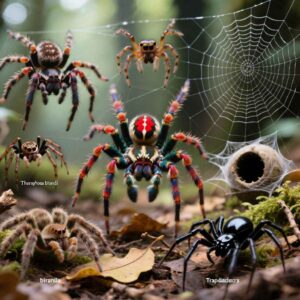
Spiders are a large group of arachnids with over 45,000 known species worldwide. They live in almost every environment except Antarctica. Many people ask, are spiders insects? They are not. Spiders belong to the order Araneae and have eight legs. Each spider species has unique behavior, size, and habitat preferences.
Some well-known types include orb-weaving spiders, huntsman spiders, tarantulas, and jumping spiders. Orb weavers are famous for their perfect, round webs. Huntsman spiders are fast hunters often found in warm regions. Tarantulas, such as the goliath birdeater, are among the largest spiders. Jumping spiders impress with their vision and leaps.
There are also fascinating aquatic types like the water spider (Argyroneta aquatica) that live underwater. The black widow and brown recluse are known for their venom. Each spider species uses different hunting methods, from silk traps to active chasing. Their diversity makes them an important part of ecosystems.
Scientists classify spiders into major groups such as mygalomorphs, araneomorphs, and mesothelae. These groups include families like Araneidae, Theraphosidae, and Nephilidae. With so many forms and adaptations, spider species remain one of nature’s most varied and interesting predators. Studying them gives us insight into survival, evolution, and the balance of our environment.
Spider Anatomy and Unique Features
Spiders are arachnids, not insects, and have unique body structures that set them apart. Their body is divided into two main parts: the cephalothorax and the abdomen. The cephalothorax holds the eyes, mouthparts, and legs, while the abdomen contains vital organs and silk-producing glands used for making webs and egg sacs.
A spider’s 8 legs are made of segments: coxa, trochanter, femur, patella, tibia, metatarsus, and tarsus. These legs end with tiny claws that help them grip surfaces. Many spider species also have sensory hairs, called setae, that detect vibrations and changes in the air, making them excellent hunters even in the dark.
One of the most remarkable features of spiders is their spinnerets, located at the end of the abdomen. These are silk-spinning organs connected to silk glands. The silk is strong, flexible, and used in web construction, ballooning, wrapping prey, or creating shelters. Some spiders even make silk bridges for travel.
Spiders also have specialized mouthparts called chelicerae, tipped with fangs that deliver venom to immobilize prey. Behind these are pedipalps, which look like small legs but help in sensing, feeding, and reproduction. Their exoskeleton provides protection and support, while internal structures like the endosternite give extra strength without adding heavy weight.
Another unique feature is their highly adapted eyes. Most spiders have eight simple eyes, but vision varies by species. Jumping spiders have excellent eyesight for hunting, while web-builders rely more on vibrations. Combined with their agility, silk abilities, and sensory adaptations, these features make spiders some of nature’s most efficient and fascinating predators.
Read More: Scorpion
Spider Habitats Around the World
Spider habitats around the world are amazingly diverse. Spiders live in forests, deserts, grasslands, caves, and even underwater. From hot tropical jungles to freezing mountains, spider species adapt to survive anywhere. Their webs, burrows, and hiding spots make them skilled survivors everywhere.
Habitat:
Habitats of spiders are incredibly diverse. You can find them almost everywhere except Antarctica. They live in forests, deserts, grasslands, mountains, and even underwater. Some build webs in gardens, while others hide under rocks. Their adaptability makes them one of nature’s most successful survivors.
Spiders choose habitats based on food, shelter, and safety. In homes, they settle in quiet corners, basements, or attics. In nature, many weave webs between tree branches or tall grass. Active hunters prefer hiding spots where insects pass frequently.
Certain spider species live in extreme places. The water spider, for example, survives in ponds using an underwater silk bubble. Some desert spiders burrow deep to escape heat. This wide range of living conditions shows how versatile spiders are.
Human activity changes spider habitats. Deforestation, pollution, and climate change push some species to adapt or move. Yet many thrive near people, helping control pests. Protecting habitats supports both spiders and environmental balance.
What Do Spiders Eat and Hunt?
Spiders are skilled predators that eat mainly insects. They hunt using webs, silk snares, or active hunting. Common prey includes flies, grasshoppers, and other arthropods. Some spiders, like Bagheera kiplingi, even eat plant material, showing surprising dietary variety.
Eat:
Spiders mainly eat insects, making them natural pest controllers. They catch grasshoppers, flies, moths, and other small arthropods. Some larger species like the goliath birdeater may even eat small birds or lizards. Most spiders use venom to immobilize prey before feeding. Their diet depends on their species and habitat.
Spiders don’t chew like humans. They inject digestive enzymes into their prey, turning it into a liquid meal. They then suck up this nutritious fluid. Orb-weaving spiders wrap insects in silk before eating. Active hunters like Bagheera kiplingi sometimes steal plant material or prey. Spiders adapt their diet to available food.
Some spiders, like black-and-yellow argiope (Argiope aurantia), focus on flying insects caught in webs. Tarantulas eat larger prey, including small mammals and amphibians. Water spiders (Argyroneta aquatica) capture insects underwater using air bubbles. Ballooning juveniles catch tiny prey while floating in the northern jet stream. Each spider species has unique feeding methods.
Spiders also practice selective eating. They may reject certain prey if it’s too large or dangerous. Cheiracanthium inclusum prefers smaller insects, while baboon spiders hunt larger arthropods. This balance ensures survival and pest control. Spiders’ feeding habits are crucial for maintaining healthy ecosystems worldwide.
Hunting:
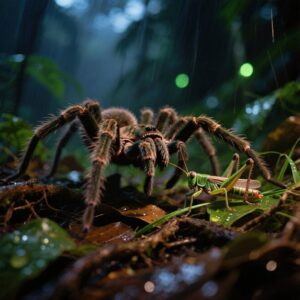
Some spiders are active hunters and don’t rely on webs. Huntsman spiders (Sparassidae) chase prey across trees and walls. Mygalomorphs like tarantulas ambush animals from burrows. These predators use keen sense organs, speed, and camouflage. They detect vibrations and movement to locate insects or small vertebrates nearby.
Orb weavers (Araneidae) build silk snares to trap flying insects. The black-and-yellow argiope spins intricate webs to catch grasshoppers, flies, and beetles. Web construction is a mix of instinct and skill. Silk bridges and bridging locomotion help spiders explore areas and expand hunting zones efficiently.
Some species specialize in unusual prey. Bagheera kiplingi primarily feeds on plant matter but hunts insects opportunistically. Water spiders hunt underwater using silk to form air pockets. Even American tarantulas and pinkfoot goliath (Theraphosa apophysis) ambush bats, frogs, or small rodents. Predatory tactics vary widely across spider species, highlighting their adaptability.
Hunting also involves strategy and patience. Spiders use venom injection to subdue prey safely. Pedipalps and chelicerae aid in capturing and holding food. Autotomy allows them to escape threats mid-hunt. Whether using silk snares or stalking actively, spiders remain highly effective predators in every environment.
Breeding:
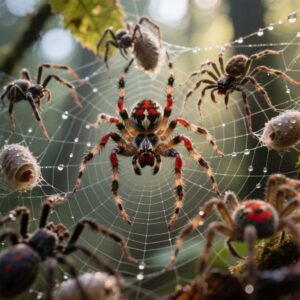
Spiders usually breed once a year, depending on the species. Most species prefer warmer months for mating, often between spring and early summer. Male spiders actively search for females, sometimes traveling long distances. After mating, females store sperm to fertilize eggs later. Timing is key for successful reproduction.
A female spider lays eggs in silk sacs, which can contain dozens to hundreds of spiderlings. For example, orb-weaving spiders may produce 50–200 eggs, while larger tarantulas like the goliath birdeater can produce over 100. The mother carefully guards the eggs, using silk wrappings to protect them from predators and harsh weather.
Spiderlings hatch after a few weeks and often face immediate challenges. Many young spiders fall prey to birds, ants, or other spiders. Food scarcity can also affect survival rates. Ballooning helps some spiderlings disperse safely to new locations, but many still face obstacles before reaching adulthood.
Breeding spiders encounter several difficulties. Mating can be risky, as males sometimes get eaten. Environmental changes, pollution, and habitat destruction reduce suitable breeding sites. Human activities like pesticide use and deforestation further threaten survival. Despite these challenges, spiders continue to reproduce successfully, maintaining their vital role in controlling insect populations.
Size and Weight:
Spiders vary greatly in size and weight. Small species, like the jumping spider, may be just a few millimeters long and weigh less than a gram. Large spiders, such as the goliath birdeater, can reach 12 inches in leg span and weigh over 170 grams. Most spiders fall somewhere in between, with size and weight depending on the species, age, and environment. This variety helps them adapt to different habitats and hunting styles, from tiny orb weavers building delicate webs to massive tarantulas roaming the forest floor. Knowing their size and weight gives insight into how spiders survive and thrive in nature.
Lifespan:
The lifespan of spiders varies widely. Small spiders may live less than a year, while tarantulas like the goliath birdeater can live over 20 years. Factors include species, environment, and availability of food.
Are Spiders Dangerous to Humans?
Most spiders are not dangerous to humans. They usually avoid contact and only bite in self-defense. Even if a bite occurs, it often causes mild irritation or redness. Only a few species, like the black widow or brown recluse, have venom strong enough to cause serious medical issues.
Spiders rarely attack humans. They hunt insects and other small prey, not people. Their venom is designed to immobilize prey, not harm large animals. Encounters usually happen by accident, like touching a web or cornering a spider. Staying calm and avoiding sudden movements reduces the chance of being bitten.
While some spiders like Australian funnel-web spiders or certain tarantulas are more dangerous, they are rarely encountered by the average person. Most spiders contribute positively by controlling pests. Understanding spider behavior helps humans respect them without fear, knowing attacks are extremely uncommon.
Spider Web Types and Their Uses
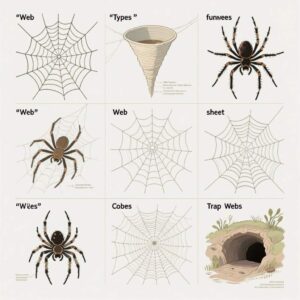
Spiders spin different web types depending on their species and hunting style. The most common is the orb web, used by orb weavers (Araneidae). These circular webs trap flying insects like flies and moths. Orb webs are often built in gardens, forests, and near lights to catch prey effectively.
Cobwebs, or tangled webs, are built by house spiders like the black widow (Latrodectus). They are irregular and sticky, perfect for catching crawling insects. Cobwebs often appear in corners, basements, or sheds. These webs help spiders stay hidden while waiting for insects to stumble into their sticky trap.
Sheet webs are flat or slightly curved and built close to the ground or in vegetation. These webs, made by species like family Linyphiidae, catch insects that fly or jump near plants. Some sheet-web spiders even add a tangle of threads above the sheet to knock insects down onto the net.
Funnel webs, spun by Australian funnel-web spiders (Atrax) and grassland species, have a funnel-shaped retreat. Spiders hide in the narrow end and rush out to catch prey. These webs are strong, sticky, and often built on the ground or between plants. Each web type is unique and serves a survival purpose.
Amazing Facts About Spiders
Spiders are incredible creatures with unique skills. They belong to the order Araneae and are arachnids, not insects. With eight legs and multiple sense organs, spiders navigate their world efficiently. Some spider species build complex webs, while others actively hunt. Their diversity is impressive, ranging from tiny jumpers to giant tarantulas.
Spider silk is one of nature’s strongest materials. It can stretch and hold weight far beyond its size. Webs are not just for catching prey—they protect eggs and create shelters. Orb-weaving spiders and araneids use silk for spinning intricate patterns. Even the smallest spiders rely on silk bridges or ballooning to move across gaps safely.
Some spiders show fascinating behaviors. For example, Bagheera kiplingi feeds mostly on plant material, unlike typical predators. Many spiders practice autotomy, dropping a leg to escape danger. Others show sexual size dimorphism, where females are much larger than males. Tarantulas and huntsman spiders have unique hunting and mating habits.
Spiders also help humans indirectly. They control pests like grasshoppers and flies, reducing the need for chemicals. Some, like black widows and brown recluses, are venomous, but most are harmless. Studying spiders reveals more about silk, venom, and predator-prey behavior. Their adaptability shows why spiders have thrived for millions of years.
FAQ’S
What do spiders eat
Spiders mainly feed on insects and other small arthropods. A spider uses its venom to immobilize prey before consuming it.
Are all spiders dangerous
Most spiders are harmless to humans. Only a few, like black widows or brown recluses, pose a real threat.
How do spiders make webs
Spiders produce silk from spinnerets. They use it to create webs, catch prey, or build protective silk wrappings.
Where do spiders live
Spiders can be found almost everywhere. They thrive in forests, deserts, homes, and even underwater, like the water spider.
Can spiders help humans
Yes, spiders control insect populations naturally. A spider acts as a predator of insects, reducing pests without using chemicals.
Conclusion
Spiders are amazing creatures that often go unnoticed. These arachnids are not insects, even though some people confuse them with bugs. A spider has eight legs, a body divided into the cephalothorax and abdomen, and special sense organs that help it detect prey. With more than 45,000 spider species, they come in many shapes and sizes. Some, like orb weavers, spin intricate webs to catch insects. Others, like huntsman spiders, are active hunters that chase their prey. Spiders use silk in many ways, from building webs and silk bridges to wrapping grasshopper prey. They even help control pests naturally, making them important for the ecosystem.
Despite their fearsome reputation, most spiders are harmless to humans. Large tarantulas, like the goliath birdeater, may look scary, but they rarely bite. A spider’s behavior is fascinating, from ballooning through the air to building silk snares. Learning about spiders shows how crucial they are in nature. Appreciating their role helps us respect these tiny but powerful arthropods.

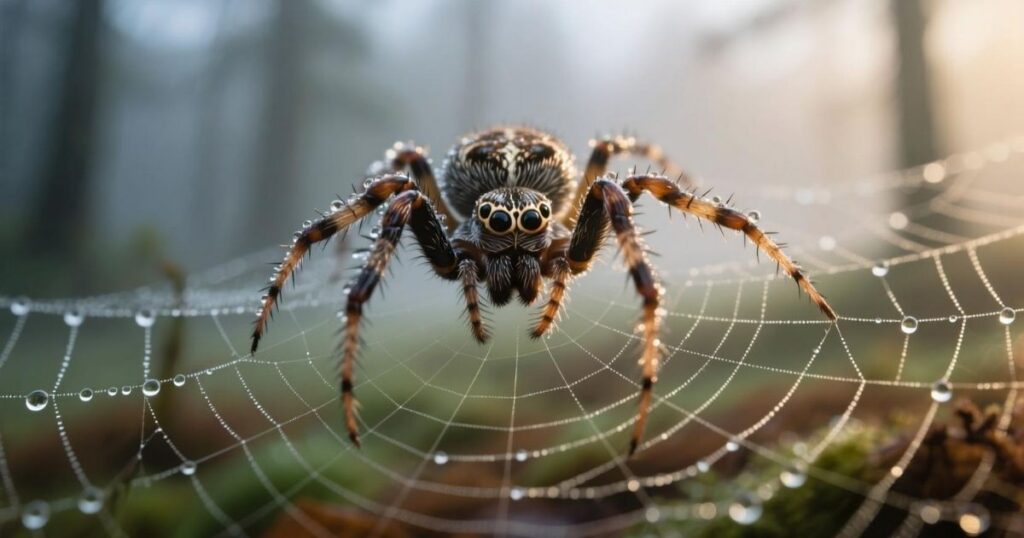
1 thought on “Spider”